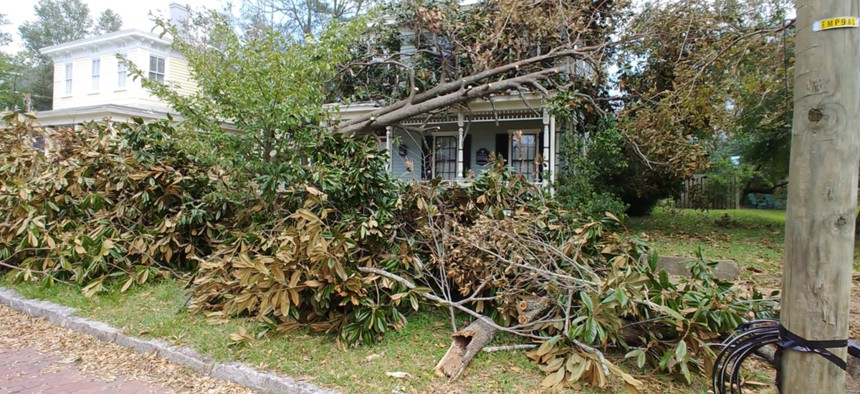A New Approach for Hurricane Recovery Efforts

Preliminary damage assessments estimated more than $450 million in real and personal property losses across the county. shutterstock

Connecting state and local government leaders
A coastal county in North Carolina created an entirely new office to coordinate recovery efforts among federal and state partners.
Faced with the daunting task of beginning recovery operations after Hurricane Florence, officials in New Hanover County, North Carolina decided on a comprehensive strategy: establishing a new office tasked solely with navigating the often-confusing bureaucracy of state and federal recovery resources.
Thus was born the Hurricane Florence Recovery Coordination Office, a five-person department housed under the coastal county’s Office of Strategy. Current staff members were diverted from other agencies, while two new positions will most likely be outside hires.
The office does not provide assistance directly to residents. Instead, staff members focus on helping local agencies and nonprofits navigate the various funding streams available for recovery efforts from federal and state entities. That includes everything from FEMA disaster relief to funding from the Department of Education, the Justice Department, the state Department of Transportation and the federal highway program, among others.
“There are a whole host of funding streams that become available when you have a disaster of this magnitude, and there are so many different rules that govern each one of these programs that it really does take a thoughtful plan to think through how you accomplish this in a way that makes sense,” said Beth Schrader, the county’s chief strategy officer and Hurricane Florence recovery manager. “We’re learning as we go. It’s very much drinking from a fire hose.”
New Hanover County, tucked in the state’s southeastern corner along the Atlantic Ocean, is no stranger to hurricanes. But Hurricane Florence was different. The storm started as a category 4 and was downgraded to a category 1 before it made landfall in Wrightsville Beach, stalling out over the area and dumping more than 30 inches of rain on the region. Even for an area accustomed to storms, it was a harrowing and completely new experience.
“You had tornadoes that were spawned. The night of the storm we had so many tornadoes that spun off, one even hit the base camp we were attempting to set up,” Schrader said. “The magnitude of what we saw and the response we had to set up was unlike anything in recent memory.”
The resulting damage was significant. Preliminary damage assessments estimated more than $450 million in real and personal property losses across the county, with untold millions tacked on from lost tourism and economic activity.
“The hurricane disrupted our homes, our businesses and our labor market. It impacted our infrastructure and other business capital, and our entire population was affected,” County Manager Chris Coudriet wrote in a county bulletin this month. “Recovery from Hurricane Florence has begun, but it will take coordinated planning and state and federal resources to help build a stronger and more resilient Cape Fear region.”
That’s the overarching goal of the recovery office, Schrader said. Though the storm and its aftermath are unique, staff members are not building the county’s recovery operation entirely from scratch. Housing the department under the existing Office of Strategy ensures that staff members approach hurricane recovery as part of the county’s overall long-term plan—part of an effective, long-term strategy focused largely on resiliency.
“There are elements of what we’re doing that link to strategic initiatives that we already had—things like housing and the economy and business development and jobs,” Schrader said. “These are all intimately and inextricably intertwined with our long-term strategy. [The recovery office] is not an uncommon concept, but you need to have dedicated resources that can really think it through. If it’s not part of anyone’s job, it’s hard to have the focus and dedication.”
The office officially opened on Oct. 15. Since then, staff members have accomplished several recovery goals, including the approval of a zoning ordinance text amendment that allows displaced residents who are eligible for FEMA’s direct temporary housing assistance to place RVs on their property. The amendment, approved by the county’s Board of Commissioners at a special meeting, allows residents to continue with their normal day-to-day lives even while waiting for their homes to be repaired.
“Those types of recovery programs, even in these early stages, make such a difference moving forward,” said Kate Murphy, communications and outreach coordinator for the Hurricane Florence Recovery Office. “People can stay in their school district and their communities and near the grocery store they always go to— all those creature comforts that make the long haul a little more manageable.”
There’s no timeline for recovery, though Schrader said she expects the office to be a physical presence in the county for at least three years.
“We are very much in the early stages. I think we are very, very cognizant that the impacts being felt are really about people and our citizens. It’s about our businesses, it’s about our economy. We live here, so obviously we would like to see the recovery progress as quickly as possible,” she said. “But we’re just beginning. Just like we saw such creativity and thoughtfulness and performance during the actual event and immediately in the days following it, we are going to put that same level of creativity and thoughtfulness and dedication to the long-term recovery.”
Kate Elizabeth Queram is a Staff Correspondent for Government Executive’s Route Fifty and is based in Washington, D.C.

NEXT STORY: USGS Updates National Volcanic Threat Assessments for 1st Time Since 2005




